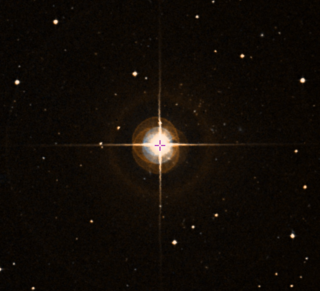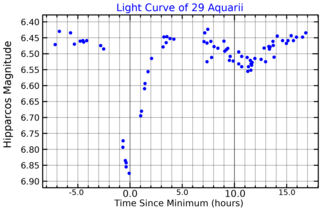
Tau1 Aquarii, Latinized from τ1 Aquarii, is the Bayer designation for a single star in the equatorial constellation of Aquarius. With an apparent visual magnitude of 5.66, it is a faint naked eye that requires dark suburban skies for viewing. Parallax measurements made during the Hipparcos mission yield a distance estimate of roughly 355 light-years from Earth. The star is drifting further away with a radial velocity of +15 km/s. It is a candidate member of the Pisces-Eridanus stellar stream.

Rho Aquarii, Latinized from ρ Aquarii, is the Bayer designation for a binary star system in the equatorial constellation of Aquarius. It is visible to the naked eye with an apparent visual magnitude of +5.34. Based upon parallax measurements, this star is at a distance of roughly 870 light-years from Earth. It is drifting closer with a radial velocity of –9 km/s. The proximity of this star to the ecliptic means it is subject to lunar occultations.

3 Aquarii is a variable star in the equatorial constellation of Aquarius. 3 Aquarii is the Flamsteed designation; it also bears the Bayer designation k Aquarii and the variable star designation EN Aquarii. With a mean apparent visual magnitude of 4.429, it is visible to the naked eye in dark skies. It has an annual parallax shift of 5.57 milliarcseconds with a 5% margin of error, which translates to a physical distance of around 590 light-years from Earth.
47 Aquarii, abbreviated 47 Aqr, is a star in the zodiac constellation of Aquarius. 47 Aquarii is its Flamsteed designation. It is a faint star but visible to the naked eye in good seeing conditions, having an apparent visual magnitude of 5.135. Based upon an annual parallax shift of 18.0 mas, it is located 181 light years away. At that distance, the visual magnitude of the star is diminished by an extinction of 0.088 due to interstellar dust. It is moving further from the Earth with a heliocentric radial velocity of +48 km/s.
68 Aquarii is a single star located 270 light years away from the Sun in the zodiac constellation of Aquarius. 68 Aquarii is its Flamsteed designation, though it also bears the Bayer designation of g2 Aquarii. It is visible to the naked eye as a dim, yellow-hued star with an apparent visual magnitude of 5.24. The object is moving further from the Earth with a heliocentric radial velocity of +24.5 km/s.
42 Aquarii is a single star located 447 light years away from the Sun in the zodiac constellation of Aquarius. 42 Aquarii is its Flamsteed designation. It is visible to the naked eye as a faint, orange-hued star with an apparent visual magnitude of 5.34. This object is moving further from the Sun with a heliocentric radial velocity of around +13 km/s.
103 Aquarii is a single star in the equatorial constellation of Aquarius. 103 Aquarii is the Flamsteed designation, although it also bears the Bayer designation A1 Aquarii. It is faint but visible to the naked eye as an orange hued star with an apparent visual magnitude of 5.34. Based upon an annual parallax shift of 4.69 mas, the distance to this star is around 700 light-years (210 parsecs). It is moving away from the Earth with a heliocentric radial velocity of +25 km/s.
7 Aquarii, abbreviated 7 Aqr, is a binary star system in the zodiac constellation of Aquarius. 7 Aquarii is the Flamsteed designation. It is visible to the naked eye with an apparent visual magnitude of 5.5; the brighter component is baseline magnitude 5.62 while the faint secondary is magnitude 11.4. As of 2002, the pair had an angular separation of 2.10″ along a position angle of 165°. The distance to this system, based upon an annual parallax shift of 4.9 mas, is around 660 light years. It is moving closer to the Earth with a heliocentric radial velocity of −32 km/s.
77 Aquarii is a single star located 135 light years away from the Sun in the equatorial constellation of Aquarius. 77 Aquarii is its Flamsteed designation. It is visible to the naked eye as a dim star with a baseline apparent visual magnitude of 5.55. The star is moving closer to the Earth with a heliocentric radial velocity of −35 km/s.
44 Aquarii is a single star located 336 light years away from the Sun in the equatorial constellation of Aquarius. 44 Aquarii is its Flamsteed designation. It is visible to the naked eye as a dim, yellow-hued star with an apparent visual magnitude of 5.75. This body is moving away from the Earth with a heliocentric radial velocity of +7.4 km/s.
50 Aquarii, abbreviated 50 Aqr, is a single star in the zodiac constellation of Aquarius. 50 Aquarii is its Flamsteed designation. It is a faint star with an apparent visual magnitude of 5.76 that is barely visible to the naked eye under good seeing conditions. The star is located near the ecliptic and thus is subject to lunar occultations. Based upon an annual parallax shift of 12.2 mas as seen from Earth orbit, it is located 266 light years away. It is moving closer to the Earth with a heliocentric radial velocity of −21 km/s.
74 Aquarii is a triple star system in the constellation of Aquarius. 74 Aquarii is its Flamsteed designation and it also bears the variable star designation HI Aquarii. The combined apparent visual magnitude is 5.8, although it is very slightly variable, and it is located at a distance of 590 light-years from Earth.
15 Aquarii, abbreviated 15 Aqr, is a single, blue-white star in the zodiac constellation of Aquarius. 15 Aquarii is the Flamsteed designation. It is a dim star that is just visible to the naked eye under good viewing conditions, having an apparent visual magnitude of 5.83. Based upon an annual parallax shift of 4.6 mas, it is located around 710 light years away. At that distance, the visual magnitude is diminished by an extinction of 0.18 due to interstellar dust. It is moving closer to the Earth with a heliocentric radial velocity of −9 km/s. Relative to its neighbors, 15 Aqr has a peculiar velocity of 28.7+2.9
−3.1 km/s and may be a runaway star.
60 Aquarii is a star located 375 light years away from the Sun in the equatorial constellation of Aquarius. 60 Aquarii is its Flamsteed designation. It is visible to the naked eye as a dim, yellow-hued star with an apparent visual magnitude of 5.89. The star is moving closer to the Earth with a heliocentric radial velocity of –8 km/s.

70 Aquarii is a variable star located 425 light years away from the Sun in the equatorial constellation of Aquarius. It has the variable star designation FM Aquarii; 70 Aquarii is the Flamsteed designation. It is near the lower limit of visibility to the naked eye, appearing as a dim, yellow-white hued star with a baseline apparent visual magnitude of 6.19. This star is moving closer to the Earth with a heliocentric radial velocity of –5.8 km/s.

78 Aquarii is a star in the constellation of Aquarius. 78 Aquarii is its Flamsteed designation. Based on stellar parallax measurements made by Gaia, it is located about 600 light-years from the Sun.

29 Aquarii is a binary star system located around 590 light years away from the Sun in the equatorial constellation of Aquarius. 29 Aquarii is the Flamsteed designation; the system also bears the variable star designation DX Aquarii. It is a challenge to view with the naked eye, appearing as a dim star with a combined apparent visual magnitude of 6.39. The system is moving further from the Earth with a heliocentric radial velocity of about +15 km/s.

EW Aquarii, or HR 8102, is a variable star in the equatorial constellation of Aquarius. With an apparent visual magnitude that fluctuates around 6.47, it is a dim star near the lower limit of visibility to the naked eye. The star is located at a distance of approximately 439 light years from the Sun based on parallax, but is drifting closer with a radial velocity of −39 km/s. The star is positioned near the ecliptic and thus is subject to lunar occultations. It may be a member of the Hyades Group.
28 Aquarii is a single star located about 560 light years away from the Sun in the zodiac constellation of Aquarius. 28 Aquarii is the Flamsteed designation. It is visible to the naked eye as a dim, orange-hued star with an apparent visual magnitude of 5.6. This object is moving further from the Earth with a heliocentric radial velocity of +8.1 km/s.
40 Aquarii is a star in the equatorial constellation of Aquarius. 40 Aquarii is its Flamsteed designation; it was too faint to be included in the Bright Star Catalogue. The brightness of this star is below the normal limit for visibility with the naked eye, having an apparent visual magnitude of 6.93. Based upon parallax measurements, it is located about 726 light-years away from the Sun. It is moving closer to the Earth with a heliocentric radial velocity of -3 km/s. 40 Aquarii is positioned near the ecliptic and thus is subject to lunar occultations.






